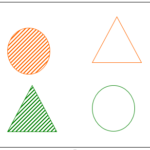What is Math?
posted by Lisa Ginet
When you hear or see the word “math,” what do you think of? Your high school algebra class? Balancing your checkbook? A geeky engineer with pocket protectors? When you add “early childhood” to “math,” what do you think of then? A little one learning to say, “1, 2, 3, 4, 5, 6, 7, 8, 9, 10”? A bright poster with a circle, triangle and rectangle neatly labeled? All of these are common ideas about what math is and how math starts, but none of them are what I mean when I say “foundational math.” Before I tell you what I do mean, I want you to try something.
Look at this image:
 Consider this question:
Consider this question:
Which of the figures are the same?
Often when I ask this, a person says, “They are all different from each other.” Another says, “They are all the same; they are all shapes.” Both of these answers make sense, but I often ask people to keep looking to see if anyone can come up with another answer. Usually, people then generate these six answers:
- top two shapes are both orange
- bottom two shapes are both green
- left two shapes are both striped
- right two shapes are both solid
- top left and bottom right are both circles
- top right and bottom left are both triangles
In fact, although none of the two shapes are identical to each other, any two of them are “the same” in some way. Figuring this out involves logical thinking about the attributes of the shapes.
This shape activity demonstrates one definition of mathematics – a logical way of thinking that allows for increasing precision. We can use math to make sense of the world. We can use math to solve problems. To use math in these ways, though, we cannot just memorize facts. We must build our own understanding, so that we can think flexibly in different situations. Without a strong foundation, a tall building would not stand for long. Likewise, without a strong foundation in mathematical concepts, children can struggle to understand the more complex mathematical thinking they need later in life.
At the Early Math Collaborative, we have developed a set of 26 “Big Ideas” – key mathematical concepts that lay the foundation for life-long mathematical learning and thinking. While these concepts can be explored at any early age, they are powerful enough that children can and should engage with them for years to come. As you engaged in the shape activity earlier, you were using two of the Big Ideas:
- Attributes can be used to sort collections into sets.
- The same collection can be sorted in different ways.
Most likely, you were not thinking about these ideas consciously; rather, you were looking at the shapes and thinking about them. You were using math to make sense of the puzzle I posed and to come up with a solution. This type of math may not match your prior notion of math as quickly-recalled facts and properly executed procedures. You may need to set aside some of those notions in order to develop a deep understanding of foundational math that will help you have fun doing math with children.
It is so easy for early childhood educators to forget the importance of math, especially with the very youn.
The accreditation programs want teachers to move away from commercial posters and pictures for early childhood (i.e. colors, shapes) on the walls and in the direction of manipulative items (i.e flash cards, blocks). I\’m not sure if I completely agree with it because if its on the wall students are likely to recognize it faster when they see it in real life and labeling helps students correspond the vocabulary that goes along with the items. What are other peoples thoughts on incorporating the wall decor learning tools vs manipulative\’s. However, I do believe that they need to be exposed to both not just one or the other.
Using templates like those above will help children understand concepts of shapes.
I identified the sameness by the shapes.
how can i use different forms of shapes in my math space?
I think it is appropriate to have posters and pictures up on the wall or in the areas to reinforce the ideas but the children will catch on to the ideas better if they have something to hold on to like a manipulative.